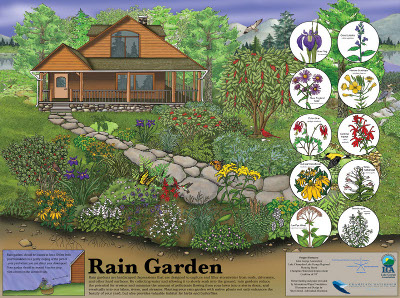
Rain gardens use soils and plants to help control runoff from impervious surfaces. They act as natural drainage systems, collecting, absorbing, and filtering stormwater runoff. Rain gardens are designed to temporarily hold rainwater in order to filter out pollutants such as oil, chemicals, and pet waste that would otherwise flow into and contaminate the closest stormwater or combined sewer system. In addition to filtering rainwater, rain gardens also increase groundwater recharge (recharge groundwater at a rate 30% greater than that of an average lawn), serve as habitats for native birds and butterflies, and make beautiful, low maintenance landscapes.
Tips for Sizing and Siting a Rain Garden
- A good rule of thumb is to size a garden using the formula: square feet of roof area x soil factor = area of garden.
- Soil factors: (Sand=0.20) (Loam=0.40) (Clay=0.50)
- A typical rain garden has a depth of 4 to 8 inches. At a depth of less than 4 inches the garden will not be able to store enough water unless it has an excessive amount of storage area. At a depth of greater than 8 inches, the garden may retain water for too long.
- The location should be one where a downspout or other source of runoff can easily be directed to.
- Pick a location that is at least 10 feet away from building foundations, and that is far from septic systems and utilities.
- A rain garden should be large enough that it drains the water that flows to it in 36 hours. This will keep the water from stagnating and allowing mosquitoes to breed.
Tips for Choosing Plants for a Rain Garden
- Rain garden plants need to be able to survive in both wet and dry conditions, as well as in the local hardiness zone.
- Choose plants that vary in height, color and blooming season to give the rain garden more diversity, as well as to increase the amount of time that the garden is in bloom.
- Pick native, non-invasive plants
Examples (from the LGA's Homeowner's Guide to Lake Friendly Living Fact Sheet Series):- Beardtongue (attracts birds, honeybees, hummingbirds, and butterflies)
- Beebalm (attracts hummingbirds and butterflies)
- Big Bluestem
- Black snakeroot
- Blue Flag Iris (attracts butterflies)
- Buttonbush (attracts birds, honeybees, and butterflies)
- Cinnamon Fern
- Columbine (attracts hummingbirds)
- Common Alexanders
- Cranesbill
- Cut-leaf Coneflower (attracts birds)
- Foamflower
- Great Blue Lobelia (attracts honeybees and hummingbirds)
- Joe Pye Weed (attracts honeybees and butterflies)
- Marsh Marigold
- Narrow Sundrops
- New England Aster (attracts honeybees and butterflies)
- Rough Goldenrod
- Royal Fern
- Sensitive Fern
- Silky Dogwood (attracts honeybees)
- Spicebush (attracts birds and butterflies)
- Switch Grass (attracts birds)
- Swamp Milkweed (attracts hummingbirds and butterflies)
- Virginia Bluebells (attracts honeybees)
- White Turtlehead (attracts butterflies)
- Wild Blue Lupine (attracts butterflies)
- Wild Ginger
- Wild Senna (attracts butterflies)
- Winterberry holly (attracts birds and honeybees)
